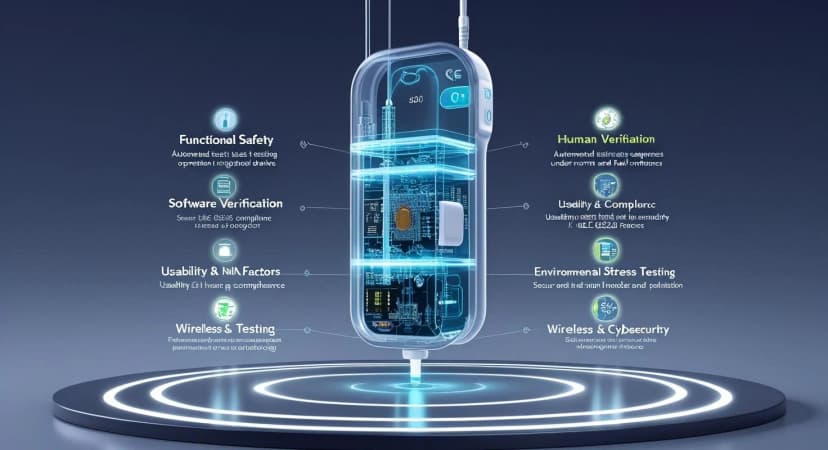Introduction
Medical devices play a critical role in healthcare by improving diagnosis, treatment, and patient outcomes. However, to ensure patient safety, these devices must meet stringent regulatory standards and undergo rigorous testing. This blog explores the importance of medical device testing, focusing on safety standards, FDA compliance, and testing connected healthcare systems (IoMT) to ensure reliability.
What is Medical Device Testing?
Medical device testing involves evaluating the safety, functionality, and performance of devices used in healthcare settings. It ensures devices are reliable, durable, and capable of performing their intended functions without causing harm to patients. The testing also verifies compliance with regulations, such as FDA standards, to ensure the device meets safety and quality requirements.
Why Medical Device Testing is Critical
1. Patient Safety
The most crucial reason for medical device testing is to ensure devices do not harm patients. Testing ensures devices function as intended and pose no risks.
2. Regulatory Compliance
Medical devices must meet regulatory standards, such as FDA regulations in the U.S. and other global bodies, ensuring devices are safe and effective.
3. Market Readiness
Rigorous testing ensures that devices are ready for market launch, reducing the risk of recalls or legal action due to safety failures.
4. Technological Integration
As medical devices become more connected through IoMT, ensuring seamless integration and security between devices and healthcare systems is increasingly important.
Key Aspects of Medical Device Testing
Safety Testing
Safety testing is the most critical part of medical device testing. It includes:
- Biocompatibility Testing: Ensuring device materials do not cause adverse reactions when in contact with the human body.
- Electrical and Mechanical Safety: Ensuring the device does not pose electrical hazards or malfunction during use.
- Risk Analysis: Identifying potential hazards and determining the risk level associated with each device feature.
Regulatory Compliance Testing
- FDA Compliance: Devices in the U.S. must comply with FDA regulations, which include rigorous quality control and performance testing.
- CE Marking (Europe): Devices for the European market must meet EU regulations to ensure safety and quality standards.
- ISO 13485 Compliance: Ensures manufacturers maintain a quality management system for medical device production.
IoMT Testing
The Internet of Medical Things (IoMT) connects medical devices to healthcare systems, allowing real-time data collection and analysis. Testing IoMT devices involves:
- Connectivity Testing: Ensuring devices communicate effectively with healthcare systems.
- Data Security: Ensuring patient data is encrypted and secure from unauthorized access.
- Interoperability: Verifying IoMT devices can seamlessly integrate with EHR/EMR platforms for smooth data exchange.
Performance Testing
- Stress Testing: Ensuring devices operate under high data volumes or extreme conditions.
- Usability Testing: Ensuring devices are easy to use by healthcare providers and minimize user errors.
Clinical Testing
Clinical trials or studies may be required to verify device effectiveness and safety in actual patient scenarios.
Common Challenges in Medical Device Testing
1. Regulatory Complexity
Regulatory requirements vary by region. Keeping up with global standards requires meticulous testing and documentation.
2. Integration with Healthcare Systems
Ensuring devices work seamlessly with EHRs and hospital management systems is complex and time-consuming.
3. Device Security
Cybersecurity is critical. Devices must be protected from hacking and data breaches to ensure patient safety.
4. Technological Advancements
Rapid advancements make devices more sophisticated, increasing testing complexity to meet safety standards without compromising innovation.
Conclusion
Medical device testing is essential to ensure devices meet safety standards, regulatory compliance, and patient expectations. By focusing on safety, performance, and compliance, manufacturers can improve patient outcomes while maintaining high-quality standards. As devices become increasingly interconnected through IoMT, data security and interoperability are crucial for their success in the healthcare industry.
If you want expert medical device testing services to ensure safety, compliance, and integration, contact us today.
FAQs
1. What is HIPAA, and how does it relate to medical device testing?
HIPAA ensures the privacy and security of patient data. Medical devices must comply with HIPAA standards, especially when handling PHI (Protected Health Information).
2. Why is testing IoMT devices crucial?
IoMT devices transmit sensitive patient data across networks. Testing ensures these devices are secure, reliable, and compatible with healthcare systems.
3. What are the key FDA requirements for medical device testing?
Medical devices must comply with FDA regulations, including quality control, performance, and safety standards.
4. How often should medical devices undergo testing?
Devices should be tested regularly, especially after updates, new releases, or regulatory changes.
5. What are common security concerns with medical devices?
Common concerns include data breaches, unauthorized access, and device vulnerabilities that can compromise patient safety.
About Jayesh Mistry
Expert in Healthcare Testing Service with years of experience in software testing and quality assurance.
Found this article helpful?
Share it with your team!
